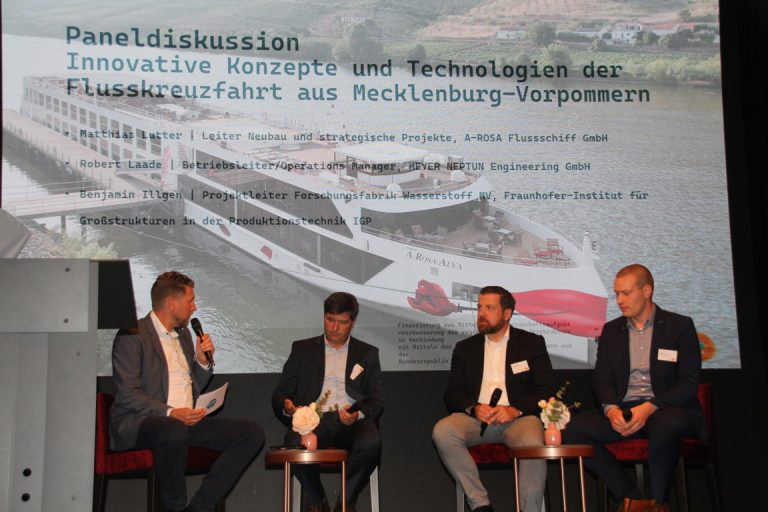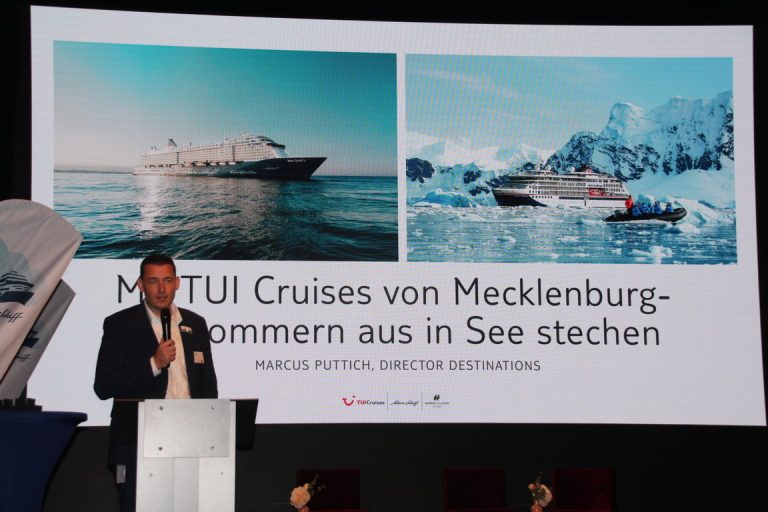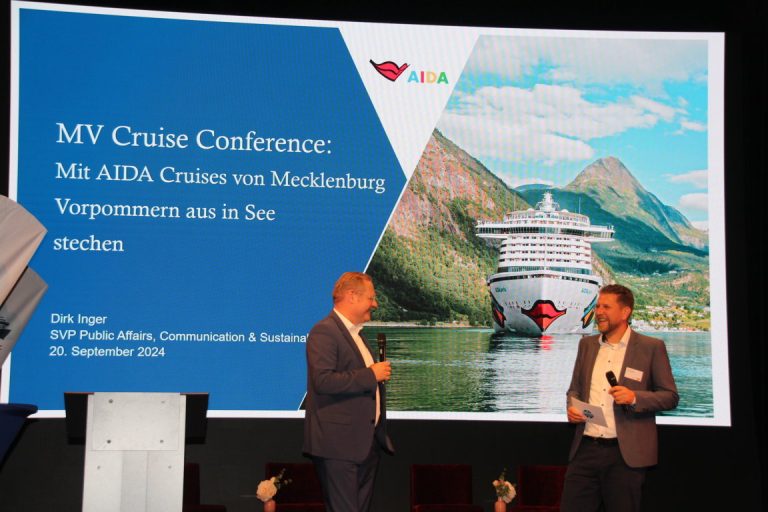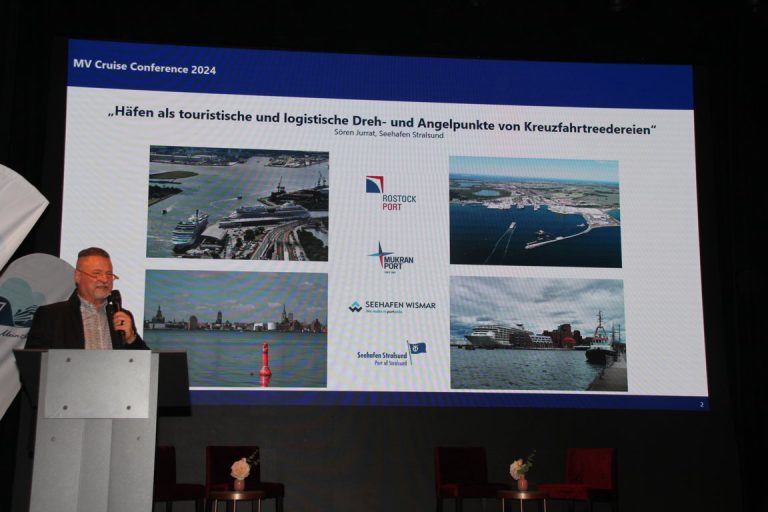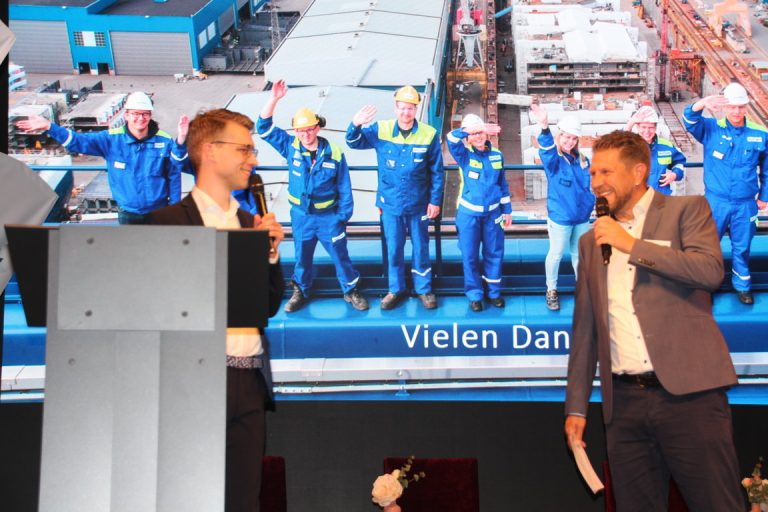Cruise Industry: The MV Cruise Conference
On September 2024, the first “MV Cruise Conference“ was held in Rostock-Warnemünde to help promote the Mecklenburg-Vorpommern ports as a cruise destination.
To strengthen the German federal state of Mecklenburg-Vorpommern (MV) as a cruise destination and to develop positive effects for its economy and the employment situation, the mutual project “MV Cruise Net” had been established in 2021. The network together with the tourism association of Mecklenburg-Vorpommern now invited its members and the maritime press to join the first “MV Cruise Conference” which was held onboard TUI Cruises’ Mein Schiff 7.
Mein_Schiff_7_MV_Cruise_Conference_Panel02_2024_Kai_Ortel
Docked for a regular passenger turnover at the Warnemünde cruise terminal on 20th September, the place was more than fitting to host the conference. With 145 calls by 36 different vessels, Warnemünde in 2024 remained by far Mecklenburg-Vorpommern’s busiest cruise port. Which positive effects does the cruise industry generate for the region? Which new technologies and concepts do the operators develop to sustainably grow the market? Which impulses can MV Cruise Net give to further enhance the experience for customers and guests alike? These and other questions were debated by representatives from cruise companies, shipyards and the ports organized with the network.
Acknowledging the fact that more than 100 guests had accepted the invitation to join the conference in the Mein Schiff 7’s large Schaubühne conference auditorium, the participants were greeted by Reinhard Meyer (SPD), Mecklenburg-Vorpommern’s minister of economics, infrastructure and tourism. Meyer emphasized that the cruise industry already was an important economic factor and employer in the region and that the cruise passengers coming to Rostock (Warnemünde), Wismar and Stralsund would spend considerable sums on land which benefitted among others the local hotel, restaurant and public service businesses. However, he stressed that yet more value creation could take place on shore. With regard to the ports, he remarked that Warnemünde was much more than just “the port for Berlin”, as many overseas operators see it. He encouraged the participants to extend their offerings to have more cruise guests spend their time in Mecklenburg-Vorpommern itself rather than on a coach or train to the German capital and back. This goes for the cities of Schwerin, Stralsund and Greifswald as well as for the island of Rügen which all are in short reach of Rostock and Warnemünde.
The federal state of Mecklenburg-Vorpommern accompanies the process in form of investments such as in shore-based power supply for cruise ships and a 200.000 € donation to MV Cruise Net.Next to speak to was Dr. Ute Fischer-Gäde (Green Party), the city of Rostock’s senator for urban development, climate affairs and mobility. She emphasized the fact that the port was still the heart of the city and that she wanted it to stay that way. However, the city was committed to support all participants in achieving the aim for the port to become climate-neutral by 2050, a goal set by the IMO in July 2023. In this context, she referred to Warnemünde and nearby Kühlungsborn becoming “greens cities by the sea”. Until 2024, the state, city and port had invested 35 MEUR into the necessary infrastructure to supply shore-power to the large cruise ships visiting Warnemünde. Aida Cruises, TUI Cruises and MSC Cruises are among the operators the ships of which already make use of these facilities.
Mein_Schiff_7_MV_Cruise_Conference_Panel02_2024_Kai_Ortel
Representing the tourism association of Mecklenburg-Vorpommern, its managing director Tobias Woitendorf followed by also emphasizing that by generating and saving jobs in the local and regional shipyard, service and other sectors, the cruise industry already was a significant factor and part of Mecklenburg-Vorpommern’s overall touristic performance. His body had hosted a parliamentary evening in Schwerin already in September 2023 in order to bring together local and regional decision makers related to the cruise industry. He also pointed to a study currently being conducted on behalf of the tourism association by dwif consulting which aims at accumulating reliable key figures and facts surrounding the cruise ship calls in Warnemünde and other MV ports. The study will be concluded in late 2025 and will include interviews with cruise passengers and crew members alike to assess their spending behaviour onboard and ashore.
Dirk Inger, Senior Vice President Public Affairs, Communication & Sustainability at Aida Cruises, spoke on behalf of the cruise operator that is routed in and connected to Mecklenburg-Vorpommern like no other. Headquartered in four buildings named AIDAhome right on the banks of the Warnow river in downtown Rostock, Aida Cruises not only is the biggest privately-owned employer in Mecklenburg-Vorpommern, but also the company with the highest number of vessel calls in nearby Warnemünde. 69 of the above mentioned 145 calls in 2024 were made by Aida Cruises’ Baltic vessels AidaDiva and AidaMar, with the season unlike in the past extending from mid-April to early-November. “And we’re working on more”, Inger remarked with a hint to Hamburg where Aida Cruises has established year-round cruising already several years ago. Aida Cruises’ main aim for the future however is to communicate the company’s and the whole industry’s sustainability efforts to the public. Inger pointed to the fact that the Aida cruise vessels were equipped with the onboard technology to use shore-power since 2007 already, but that the first port to supply the relevant facilities (Hamburg) hadn’t been ready so until 2017. He also remarked that a higher degree of networking was still necessary to achieve a successful communication to the public. A major concern also remains the fact that it was still unclear which fuel will form the basis for the fleet in the long-term, Aida Cruises and other operators continuing to struggle with eco-friendly fuels at the moment being 3 – 5 times more expensive than traditional ones.
Mein_Schiff_7_MV_Cruise_Conference_Panel02_2024_Kai_Ortel
TUI Cruises is the second major German cruise operator and although based in Hamburg has a strong seasonal presence with its Mein Schiff fleet in the port of Warnemünde as well. Marcus Puttich, director destinations at TUI Cruises, mentioned that the Min Schiff 7, host to the MV Cruise Conference, was scheduled to call at Warnemünde 6 times in 2024 (bringing 17,000 passengers and approximately 700,000 € to the port) while 8 calls were booked for the same ship in 2025 (raising the passenger number to 23,000 and the local turnover to 900,000 €). Like Aida, TUI Cruises follows an ambitious sustainability strategy and not only uses shore power for its vessels where accessible, but also runs its latest fleet addition exclusively on low-sulphur marine diesel. Above that, the ship’s engines are “multi-fuel” ready and can run on methanol as well as e-methanol which according to Puttich was planned for 2026. Unlike that, TUI Cruises’ latest newbuildings Mein Schiff Relax (2025) and Mein Schiff Flow (2026), ordered back in 2018, will run on LNG. Puttich too still sees many challenges ahead especially when it comes to port infrastructure and future fuels and emphasized the need to create awareness with the local communities regarding the contributions that cruise ships can make when calling at their ports.
Being part of the larger Royal Caribbean Cruise Lines (RCCL) group, TUI Cruises’ sister company Hapag-Lloyd Cruises with its five-strong fleet of luxury and expedition cruise ships regularly calls at smaller MV seaside towns like Heiligendamm, Binz, Ahlbeck and Kühlungsborn, making use of their own tender boats. However, just like Aida Cruises, TUI Cruises has noted an overall decrease in interest and attractiveness of the Baltic Sea region recently due to the omission of St. Petersburg as a port of call since the outbreak of the Ukraine war in 2022. New “regional possibilities” were therefore on the agenda to bring the Baltic Sea region back on the agenda of especially overseas cruise operators.
Mein_Schiff_7_MV_Cruise_Conference_Panel02_2024_Kai_Ortel
Apart from the cruise operators, Mecklenburg-Vorpommern’s shipyard industry is a strong player too when it comes to partnerships and relations with the latest local cruise initiatives. The biggest among them is the Meyer Werft Group which is not only well-known for having built 9 of the current 11 Aida Cruises ships at its core site in Papenburg, Niedersachsen, but also the whole TUI Cruises fleet through its affiliate Meyer Turku in Finland. Furthermore, Meyer owns Rostock’s Neptun shipyard which, more or less “across the road” from the Warnemünde cruise terminal, apart from building long series of river cruise ships is delivering both steel segments and main engines to all of the Meyer Werft shipyards. Florian Feimann, manager communications, sales & design at Meyer Werft, in his presentation therefore gave interesting insights into the construction process of large vessels like the Mein Schiff 7. By coincidence, 2024 also marked a ten-year anniversary for Meyer Werft which had acquired stakes in the Finnish shipbuilder in 2014 and has built not only all 7 members of the recent MEIN SCHIFF fleet since then, but also the giant Icon of the Seas, largest cruise ship in the world to date. Above that, TUI Cruises and Meyer Werft had the chance to incorporate many technological innovations and improvements when building the Mein Schiff 7 as five years had passed since the delivery the previous TUI Cruises vessel Mein Schiff 2 in early 2019. Therefore, Mein Schiff 7 has for instance been equipped with enhanced catalysators complying with the EURO 6 standard, thermic converters for food waste which produce organic pellets for agricultural re-use and a water treatment plant complying with the latest HELCOM requirements. The roof of the vessel’s “Lagune” indoor pool has even been equipped with solar panels to feed the onboard power system with solar energy.
After a fabulous lunch in either the Mein Schiff 7’s La Spezia Italian restaurant or the ship’s Anckelmannsplatz buffet restaurant, the second part of the MV cruise conference started off in the afternoon with a panel discussion themed “innovative concepts and technologies in river cruising in Mecklenburg-Vorpommern”. The debate included three participants: Matthias Lutter, head of newbuilding and strategic projects at A-ROSA Flussschiff GmbH, Robert Laade, operations manager at Meyer Neptun Engineering GmbH and Dr. Jan Sender, professor for shipbuilding at the Fraunhofer institute for large structures and production technics in Rostock. Lutter remarked that thanks to the modest size and shorter legs of travel in an environment with well-proven land-based infrastructure, river cruise ships were ideal to test new technologies like methanol-ready engines before adapting those for use in larger-scale deep-sea vessels. Furthermore, the spokesman for A-ROSA revealed that his firm was currently developing a coastal cruise ship for a deployment in the Mecklenburg-Vorpommern waters, a hybrid product which would fill the gap between the river and deep-sea cruise markets. It may be remembered that across the Atlantic, American Cruise Lines successfully operates a fleet of Constellation and Independence class coastal cruise ships in New England, the U. S. South East and Alaskan waters.
Sören Jurrat, managing director of the Seehafen Stralsund GmbH, afterwards went into explaining the role of the other MV ports as touristic and logistic hubs for cruise operators. He named Wismar, Stralsund and Sassnitz-Mukran as Mecklenburg-Vorpommern’s secondary ports that regularly hosted cruise ship calls, be it deep-sea or river vessels. All three admittedly have their advantages and disadvantages, making them suitable for one vessel type or another. While Wismar obviously suffers from being “squeezed” somewhere in the middle between Travemünde in the West and Warnemünde in the East, the city nonetheless has an amazing Hanseatic history of its own. The port of Wismar offers berths for middle-sized deep-sea cruise ships which can dock in close proximity to the UNESCO world heritage old town. Wismar has hosted vessels from Phoenix Reisen, Fred. Olsen Cruise Lines and Saga Cruises in the past and looks back on 10 calls by 9 different cruise ships in 2024. In 2025, Wismar will be welcoming vessels from Windstar Cruises and Azamara, among others.
Mein_Schiff_7_MV_Cruise_Conference
Sassnitz-Mukran on the other hand is foremost known for its role in serving the Baltic offshore and wind park industry and for hosting seasonal ferry services to Sweden and Bornholm/Denmark. However, being close to the famous white cliffs of Arkona and other attractions on the island of Rügen, Mukran is also the perfect port for all those cruise passengers who have been Rostock, Schwerin and Berlin already. The port of Mukran is easily accessible from the Baltic Sea and offers a water depth of 12.5 meters; at the same time, it is Germany’s easternmost deep-sea port. In 2024, it hosted a single deep-sea cruise vessel (Windstar’s Star Legend) but hopes to rise this number again in the future.
Stralsund as the third in the league is tailor-made for the river rather than the deep-sea cruise market. Although deep-sea vessels from operators like Plantours and Hurtigruten have visited Stralsund’s south port, the city for deep-sea ships is cut in two by the Rügendamm bridge which connects the city with the island of Rügen. Stralsund’s north port however is home to various river cruise ships which have their terminus in the Hanseatic town. In fact, Stralsund proudly calls itself Germany’s most frequented town for river cruise ships, the port recently having announced a volume of more than 18.000 guests (139 vessel calls) that have embarked or disembarked just off the famous “Oceaneum” aquarium. National operators like Phoenix Reisen and Plantours traditionally use Stralsund as a passenger turnaround port as well as international ones like Nicko Cruises, Viva Cruises or CroisiEurope.
After a number of most interesting speeches and debates, all participating members of the first MV Cruise Conference agreed that the event had been more than overdue and a great success, TUI Cruises’ fantastic Mein Schiff 7 playing her part in turning the conference into a most fruitful exchange of ideas and incentives. All 16 members in MV Cruise Net are confident to intensify relations with each other for the benefit of the Mecklenburg-Vorpommern ports and businesses in the future.
Don’t miss updates, news and reviews about the world of cruises on Cruising Journal.

